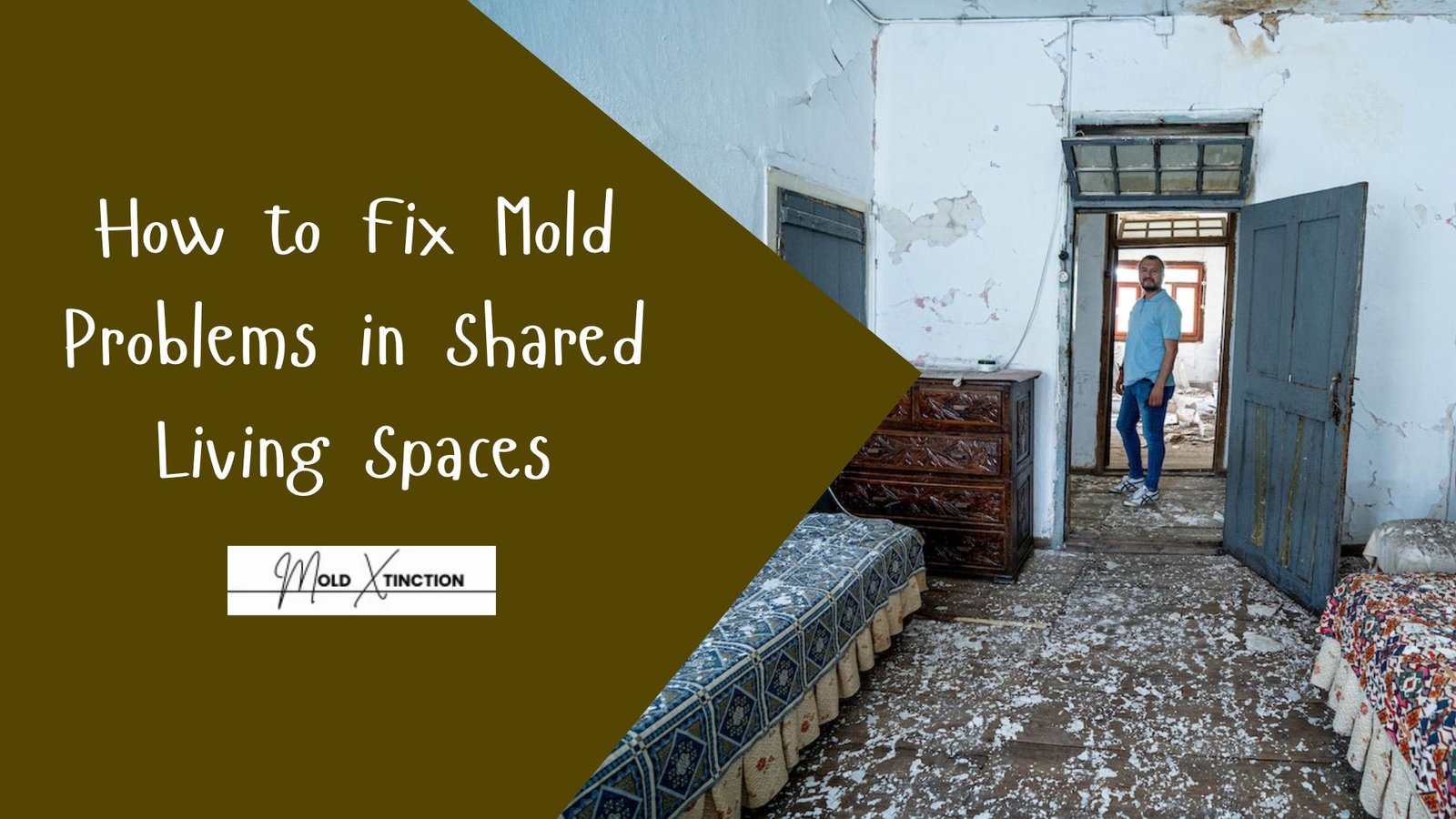If you don’t know how to fix mold problems in shared living spaces, then you need to see how it is done in this article.
Mold is all over most homes and it is even more when you live with others in an apartment, hostel or dorm.
Whenever it is getting shared by everybody on a daily basis, in the case of a room, the kitchen, even a bathroom may develop and spread quickly unless no one is cleaning up or calling attention to it early enough.
It begins with a minor thing such as a dark stain on the wall, ceiling, or bathroom.
But when left too long without attention, it becomes spreadable, damages the surfaces, stinks, and even becomes dangerous to your health.
Some people can become allergic and have breathing difficulties and sneeze because of mold.
What I would tell you is that you can do it yourself in 2 steps. I will not only show you some signs to look out for, but I will also let you know when to call in professional help.
Read below, how to fix up mold problems in shared residential places and prevent their recurrence.
Why Mold Is Common in Shared Living Spaces
Common places where molds grow are dorms, rented apartments or houses. This is because of several reasons.
So below we provide you with what may be the cause and possible solutions to fix it.
1. More people = more moisture
The more people staying in a house, the more moisture released to the air. That gets added to the whole process of cooking, bathing, washing dishes and even breathing. The moisture is relegated in the space and in case the space is not well-ventilated, mold begins to grow- especially in the warm areas like kitchen and bathroom.
2. Poor Communication
In some cases, an individual may see that some mold is growing but doesn’t inform others. They think it’s not serious or someone else will take care of it. Unless acted upon immediately, the mold gets worse and harder to remove.
3. No Cleaning
There’s no regular cleaning of shared spaces. In case of no cleaning regularly, there may be molds in humid corners like the bathroom tile wall, sink in the kitchen or even beneath the carpet.
4. Pipe and Roof Leaks
Leaking pipes, roofs and windows can flood the space rented out. These leaks make the area wet. Since renters have to leave the repairs to the landlords, molds can grow if they can’t act fast.
5. No Ventilation
Small room or windows that can’t be opened is a problem because there’s no air and no warm exposure and molds can creep in.
Step-by-Step Guide: How to Fix Mold Problems in Shared Living Spaces

1. Talk to Everyone
Don’t do anything without talking to the members of your household. The mold can only be avoided by informing everybody about it and collaborating to maintain the premises clean and hygienic.
Make a group plan for cleaning, reporting or fixing the mold. If you’re in an apartment you’re renting, contact the landlord too.
Ask such questions as:
- Has anyone else noticed a musty smell?
- Are there water leaks?
- Is the bathroom always damp?
- Who has health problems made worse by mold?
2. Find the Mold Source
Mold removal is not something you can just clean and forget. Mold exists due to the overabundance of moisture somewhere. To avoid its recurrence, you will have to identify the source of moisture (e.g. the leak or the poor air circulation) and eliminate the situation.
Check mold hotspots:
- Behind furniture against cold walls
- Under the sink
- Around windows and air conditioners
- Bathroom tiles and ceilings
- Inside wardrobes and closets
Use your nose too. Mold smells like wet socks or old books.
3. Fix Moisture Problems First
Mold needs moisture or water to multiply. It won’t go away if the water problem is not fixed. That’s why finding and fixing the spot that causes mold is the very first and most important solution to get rid of it once and for all. Without water, mold will not live or recur.
This is how it can be done:
- Fix leaks. If there’s a pipe leak, call your landlord or plumber.
- Dry wet areas. Take a cloth or mop and dry the floor, walls and windows.
- Ventilate. Open up the windows daily. Take a fan to the bathroom.
- Use dehumidifier. These machines remove excess moisture in the air.
- Remove wet items. Don’t leave wet clothes or towels in rooms.
- If you live with others, agree on a shared rule to keep spaces dry.
4. Clean Mold Safely
If the covered mold is a small area, less than 3 feet, then you can clean the area yourself through proper steps.
What you’ll need:
- Gloves
- Face mask
- Soap and water or white vinegar
- Soft brush or cloth
How to clean:
- Put on your gloves and mask.
- Mix water and vinegar (1:1).
- Spray on the moldy area.4. Soft brush, not hard.
- Clean and dry thoroughly.
Don’t paint over mold. It will grow back.
5. Know When to Call the Landlord
Mold in a rented house or apartment is the landlord’s responsibility due to building problems. This would be issues like leaking pipes, broken roof or poor ventilation or no windows open. This is not your fault but should be fixed by the landlord.
Write a nice message where you explain:
- Where the mold is
- When you notice it
- What you’ve done
- Why you need professional help
Take pictures as proof. Send them along with your report.
6. Set Mold Prevention Rules With Roommates
Once the mold is gone, you gotta make sure it doesn’t come back.. One easy way to do that is by setting simple house rules that everyone can follow.
These can be things like opening windows after showering, drying tubs, and so on, and cleaning once a week. Write the rules, write them simple, and pin them in the fridge/ the wall of the common area where everyone can read them. This will be a reminder to each person to act accordingly and keep the house dry and mold free.
Example rules:
- Open windows for 15 minutes daily
- Keep the bathroom door open after showers
- Wipe kitchen counters and sink after use
- Report leaks immediately
- No drying clothes indoors without ventilation
7. Inspect Inaccessible Places Often
Mold doesn’t have to happen in an open place that you can see.
Make it a habit to check:
- Behind the fridge
- Under sinks
- Inside closets* Behind pictures
- On windowsills
Every month is good. Early is better.
8. Know When to Give Up
If the mold:
- keeps coming back
- covers a big area
- is growing on walls, ceilings or carpets
- has a strong smell
- is causing health problems
Call a mold remediation service.
Why Call a Mold Remediation Service
In some cases, mold repair is not a DIY task. Experts have the equipment and knowledge to remove all mold. They also:
- Find hidden mold you can’t see
- Use safe chemicals to kill mold
- Seal the area to stop mold from spreading
- Dry and clean the space properly
- Prevent mold from coming back
Do not jeopardize both health and home. better to call a mold remediation technician when there is any doubt.
Helpful Guide: How to Prevent Mold in Poorly Designed Houses
Conclusion
Mold in shared spaces is not a big deal provided you take the right steps as outline in this article. The key is to act fast to dry the area, coordinate and be aware of moisture or mold growing.
Start with communication. Safer clean up of small areas. Move air around. And worst of all- never ignore big mold issues.
If it recurs, call mold remediation pros immediately. This will be a permanent solution to the problem and will make your place a healthy and mold free environment.Call now.
FAQs
1. Why does mold grow in shared living spaces?
Mold- Mold will grow where there is moisture in the air. This can be caused by leaky pipes, wet clothes in the building, bad vents or high humidity. Bathrooms and kitchens are where mold usually grows.
2. How to be mold free as housemates?
The house must be dry and clean by everyone. Let in fresh air and open windows, clean wet surfaces and report immediately on leaks. There should be fans in the bathroom and clothes should not be dried inside the room without air flow.
3. What to do when we find mold?
Clean small water spots with soap and water and white vinegar go ahead. Use mask and gloves. When mold returns or spreads over a large area, inform the landlord or ask a pro to fix the situation.
4. How to fix mold in rented houses?
In most cases, landlord is responsible to fix leaks or water damage. But tenants must report it soon and keep their home dry and clean to prevent mold from growing.
Through coordination, we can prevent mold and be safe in a house by the housemates.


